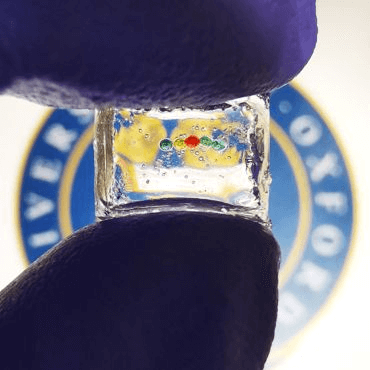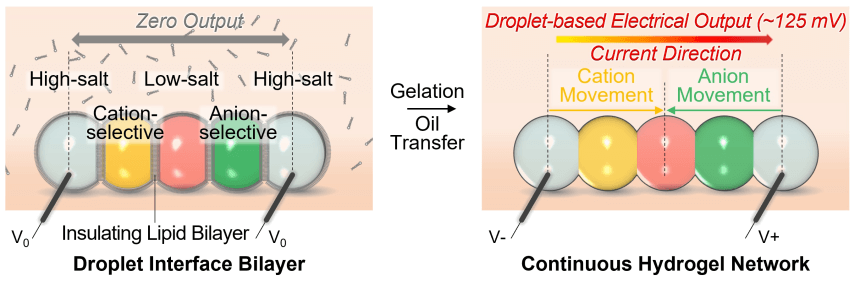Droplet Battery: Oxford's Bio-Integrated Power Breakthrough
Insights | 18-09-2023 | By Robin Mitchell
As the race for new power sources continues, researchers have recently developed a new battery technology that utilises droplets of various hydrogel liquids. What challenges do engineers face with power sources, what did the researchers develop, and does this new discovery have practical applications?
The Evolution of Power Storage: Challenges and Innovations
Over the past few decades, one interesting change in electronics has been the shift away from large, bulky devices connected to the mains to small portable devices that can be carried with ease and last for extended periods of time without needing to be charged or change the batteries. While this change has seen electronics become immensely useful, the need to carry a power source around introduces several challenges.
By far, the biggest challenge associated with energy storage technologies is their energy-to-weight ratio. Simply put, batteries need to be as small and light as possible; otherwise, devices that use them will be impractical to carry. Batteries with a high energy-to-weight ratio are able to reduce their size and weight while maintaining a suitable amount of charge capacity. If a battery’s energy-to-weight ratio is too low, then small batteries made from the technology will not be able to hold much charge, and making the battery large enough to be electrically practical will likely be too heavy to use.
But it is not just the energy-to-weight ratio that can cause engineers numerous problems. Another challenge that engineers can face is the voltage and current capabilities of that battery. For example, a battery with a large amount of charge capacity is of no use if it only produces a few millivolts across its terminals. On the flip side, a battery that is able to provide plenty of voltage but only microamps of current would be useless when trying to power anything.
Now, a battery that has sufficient charge capabilities and can produce plenty of current sounds great, but such a battery can then suffer from safety issues as it is able to put out huge quantities of energy in a short time. This is a common issue that surrounds lithium-ion batteries, which can provide engineers with a fantastic battery solution provided they can prevent the battery from getting damaged or incorrectly charged (li-ion batteries have a habit of catching fire and causing mayhem during failure events).
To make matters more complex, the environment in which a battery is used will also have a massive impact on an engineer’s choice. At sea level, most battery technologies are perfectly happy, but low-pressure environments, such as high altitude and space, can introduce all kinds of headaches, including outgassing from materials, swelling in battery structures, and issues with arcing. The same applies to extreme temperatures, whereby battery performance can significantly change in cold and hot environments.
Overall, no matter the environment or application, finding suitable energy sources for devices can be an absolute pain for engineers.
Harnessing Hydrogel: The Rise of Droplet Battery Technology
One area of engineering that is starting to see more development is implantable electronics, devices that can connect to living tissue for the sake of information exchange, enhancement, and even accelerated recovery times (such as transducers placed across bone fractures). As these technologies continue to be developed, engineers will need to find power sources suitable for use in biological environments that pose minimal risk to normal bodily functions.
Even though current battery technologies, such as lithium-iodide, are able to be implanted into the human body, their large size and ridged nature make them awkward for implants, especially micro-sized ones. Recognising these challenges, a team of researchers from the University of Oxford recently demonstrated a new battery technology, dubbed Droplet Batteries, that they claim could be the source of power for future implanted devices.
According to a recent study by the University of Oxford, this innovative droplet battery technology is inspired by how electric eels generate electricity. The device utilises internal ion gradients to produce energy. The miniaturised soft power source is crafted by depositing a chain of five nanolitre-sized droplets of a conductive hydrogel. Each droplet has a unique composition, creating a salt concentration gradient across the chain. The droplets are separated by lipid bilayers, which offer mechanical support and prevent ion flow between them. This design ensures efficient energy generation when activated.
The droplet battery, as the name suggests, is made by combining five nanolitre-sized droplets of a specific conductive hydrogel mixture. When the droplets come together, lipid bilayers form around each droplet so that they don’t combine but can stick together. This layer also prevents ions from transferring between the droplets so electrical current cannot flow.

Magnified view of the droplet energy unit for clarity. 500 nL droplets are encased in a malleable, squeezable organogel. Photo by Yujia Zhang.
When the combined droplets reach a temperature of 4˚C and the surrounding hydrogel medium changes, the droplets become active and can generate an electrical charge across its structure. Simply put, the compression of the hydrogel structure causes the lipid bilayers to collapse and merge the droplets into a continuous structure. This allows for the needed chemical reactions to occur, and electrodes placed at either side of the structure allow for powering external circuits.

Hydrogel droplet power unit activation: On the left, an insulating lipid stops ion movement between droplets. On the right, thermal gelation ruptures the lipid layers, allowing ions to flow from high-salt to low-salt droplets. Electrical output is measured using silver/silver chloride electrodes. Image: Yujia Zhang.
So far, the battery technology has demonstrated a power of around 65nW for a continuous 30 minutes. Furthermore, the battery was demonstrated to show little sign of degradation after 36 hours, indicating that it may be possible to store for extended periods of time. Finally, the researchers combined 20 of the new batteries in series to power a small 2V LED.
The research team from Oxford demonstrated the potential of this battery technology to directly regulate the activity of living cells. They attached the device to droplets containing human neural progenitor cells, which were stained with a fluorescent dye to indicate their activity. When the power source was activated, there were observable waves of intercellular calcium signalling in the neurons induced by the local ionic current. This breakthrough suggests a promising future for bio-integrated devices in therapeutic applications.
Bio-Integrated Devices: The Practical Potential of Droplet Batteries
Being cutting-edge research, this new technology won’t be used in devices anytime soon, but its flexibility and size could make it ideal for future use. Two issues that the researchers will need to address is the low activation temperature, as the human body sits around 37˚C and the potentially toxic nature of the battery. As this will be used inside the human body, the battery will need to be biologically inert and pose no danger to living tissue should it rupture.
However, if these challenges can be addressed, it is possible for this battery technology to be used in the near future. Even though 60nW isn’t a lot of power, modern electronics continue to shrink in size and operate on tiny voltages. A few of these batteries in series combined with a high-efficiency power converter could very well be used for low-cost, internal body sensors that monitor general health, such as bone regrowth, valves, and electrical activity.
Overall, the battery demonstrated by the Oxford researchers is truly impressive and certainly out-of-the-box thinking. But for now, it will remain in the lab and certainly won’t be powering mobile devices anytime soon.
Dr Yujia Zhang, the lead researcher for the study at the Department of Chemistry, University of Oxford, believes that this miniaturised soft power source represents a significant advancement in bio-integrated devices. By harnessing ion gradients, they have developed a system that can regulate cells and tissues on the microscale, paving the way for potential applications in biology and medicine. The modular design of the device also allows for scalability, suggesting its potential in powering next-generation wearable devices, bio-hybrid interfaces, and even microrobots.

